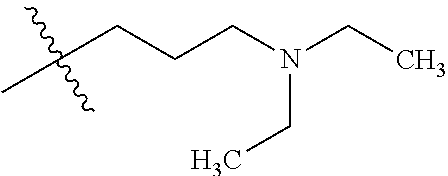Kinase inhibitor with improved solubility profile
a kinase inhibitor and solubility technology, applied in the field of kinase inhibitors with improved solubility profiles, can solve the problems of limited aqueous solubility, precipitation of compounds, and difficulty in intravenous formulations
- Summary
- Abstract
- Description
- Claims
- Application Information
AI Technical Summary
Benefits of technology
Problems solved by technology
Method used
Image
Examples
example 1a
1-(4-(4-amino-7-iodothieno[3,2-c]pyridin-3-yl)phenyl)-3-(3-fluorophenyl)urea
[0122]A solution of 1-(4-(4-aminothieno[3,2-c]pyridin-3-yl)phenyl)-3-(3-fluorophenyl)urea (example 49 in WO2005 / 10009) (12.2 g, 32.2 mmol) and pyridine (75 mL) in tetrahydrofuran (250 mL) was treated with iodine (36.8 g, 145 mmol) at room temperature. The reaction mixture was heated to 50° C. for 3.5 hours, then cooled to room temperature and treated with 20% aqueous KOH (18.1 g) followed by a 10% aqueous NaHSO3 solution (134 g) added in portions. The resulting mixture was heated to 60° C., diluted with water (366 mL), cooled to room temperature, and filtered. The wet cake was dried to provide the title compound.
example 1b
[0123]Methyl 4-amino-3-(4-(3-(3-fluorophenyl)ureido)phenyl)thieno[3,2-c]pyridine-7-carboxylate Example 1A (10.37 g, 20.56 mmol) in methanol (100 ml) was added to [1,1′-bis(diphenylphosphino)ferrocene]dichloropalladium(II) dichloromethane (0.29 g, 0.397 mmol) and triethylamine (5.53 ml, 39.7 mmol) in a 250 mL SS pressure bottle. The mixture was pressurized with carbon monoxide (60 psi), and stirred for 4 hours at 80° C. The suspension was transferred to a 1 L recovery flask and then concentrated. Water (200 ml) was added and the resulting suspension was stirred for 30 minutes and it was filtered to give the crude product. The crude material was suspended in 4% methanol in dichlormethane and filtered to provide the title compound as a solid. The filtrate was concentrated and flash chromatographed (50 mm; 4% methanol in dichlormethane) to give additional title compound.
example 1c
4-amino-3-(4-(3-(3-fluorophenyl)ureido)phenyl)thieno[3,2-c]pyridine-7-carboxylic acid
[0124]A suspension of example 1B (7.66 g, 17.55 mmol) in tetrahydrofuran (117 ml) and methanol (58.5 ml) was treated with 2M aqueous lithium hydroxide (43.9 ml, 88 mmol) and heated at 70° C. for 1 hour. The resulting suspension was filtered to remove solid material and was concentrated under a stream of nitrogen. The resulting solid was suspended in 80 ml of water. The mixture was adjusted to a pH of 5-6 with 6M aqueous HCl and filtered with water washes to provide the title compound after drying.
PUM
| Property | Measurement | Unit |
|---|---|---|
| time- | aaaaa | aaaaa |
| temperature | aaaaa | aaaaa |
| temperature | aaaaa | aaaaa |
Abstract
Description
Claims
Application Information
 Login to View More
Login to View More - R&D
- Intellectual Property
- Life Sciences
- Materials
- Tech Scout
- Unparalleled Data Quality
- Higher Quality Content
- 60% Fewer Hallucinations
Browse by: Latest US Patents, China's latest patents, Technical Efficacy Thesaurus, Application Domain, Technology Topic, Popular Technical Reports.
© 2025 PatSnap. All rights reserved.Legal|Privacy policy|Modern Slavery Act Transparency Statement|Sitemap|About US| Contact US: help@patsnap.com



